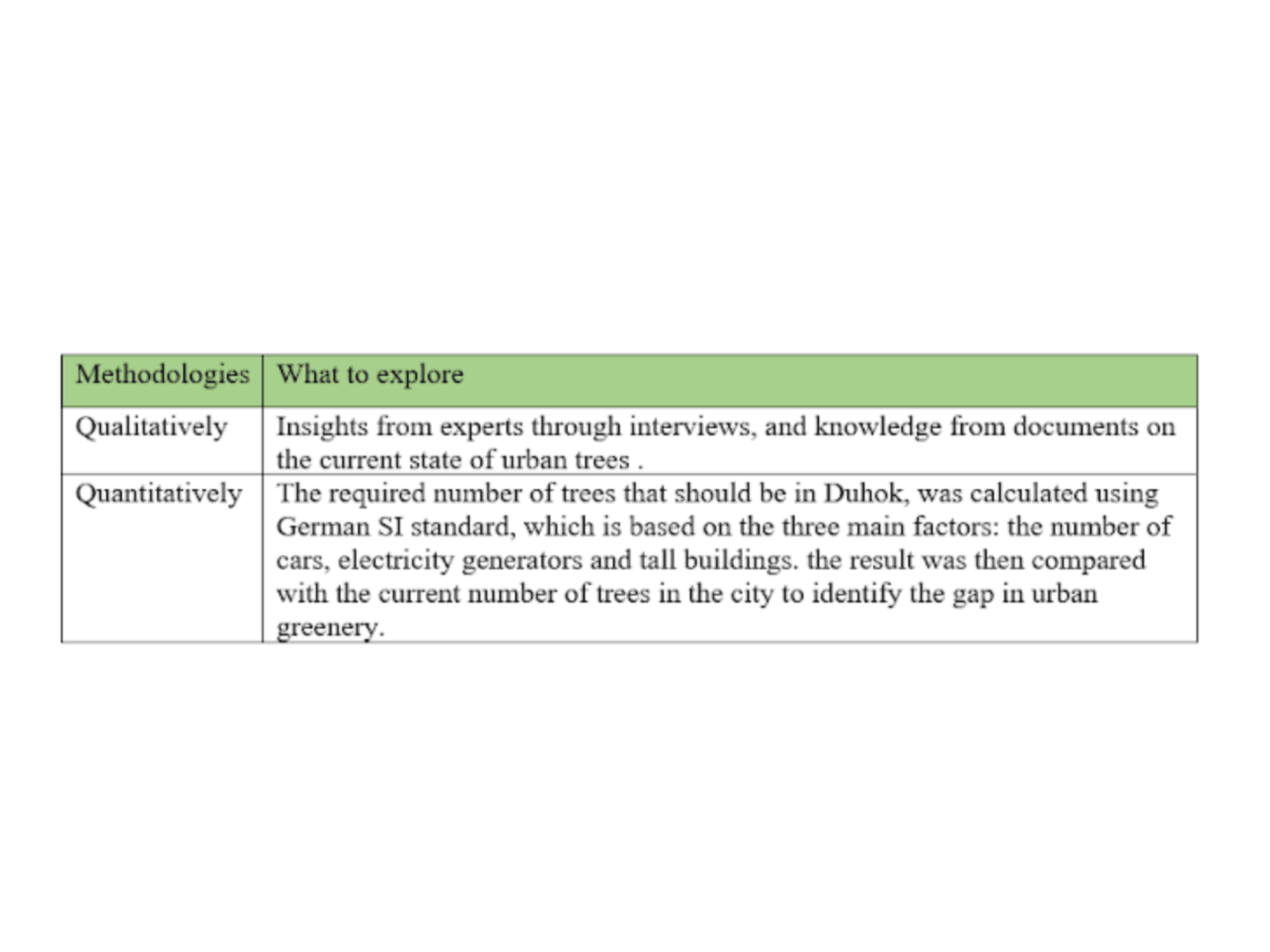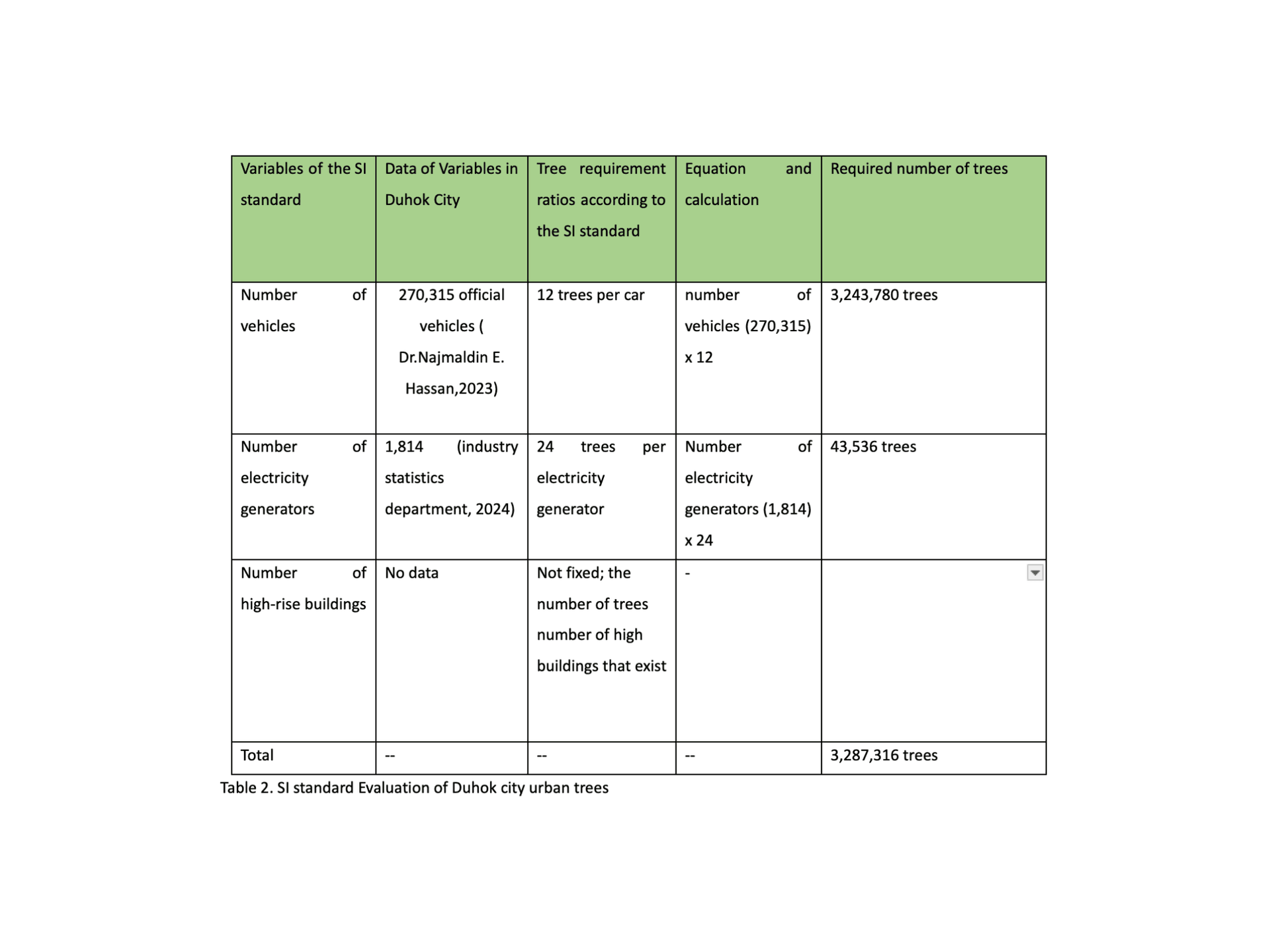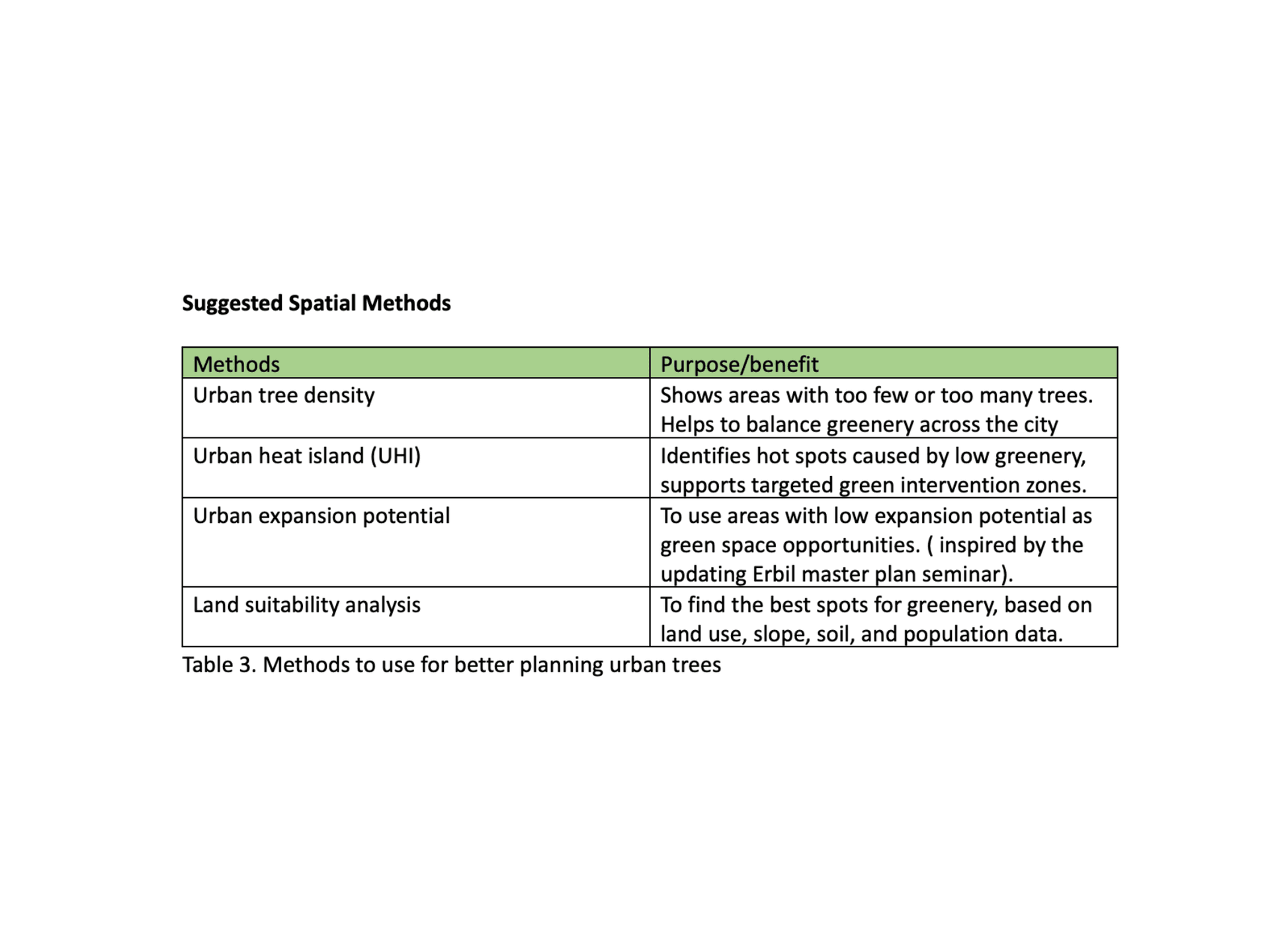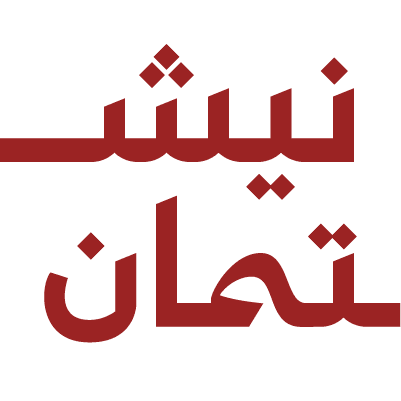Evaluating urban trees protection and management in Duhok governorate of Kurdistan
Introduction
Urban trees play a significant role in mitigating climate change and enhancing the overall environmental condition of any city. However, in some metropolitan areas, these important green spaces are not properly protected, leading to deforestation and the loss of their benefits.
Duhok governorate is in the Kurdistan region, a mountainous destination between magnificent Valleys. It has an abundance of fertile plains, trees all around the city, and forests (Duhok province) like Zawita, which contains a ridge 70% covered by pine forest, but oak woodlands also exist here (Nature Iraq). These features have significant environmental benefits. Fig. (1) shows plenty of Duhok governorate’s woodland land.
Despite having these important naturally grown trees and woodland areas in the Duhok governorate, there is uncertainty about whether they are adequately protected and managed. These resources might be at risk of deforestation or insufficient conservation efforts, potentially contributing to the increasing effects of climate change. This research seeks to evaluate whether the urban trees of the Duhok governorate are being protected and managed. It aims to provide some proper evidence on the current state of urban tree protection and management. By following the research question; How is the current situation of urban trees in Duhok governorate? Understanding the true status of trees and forestry areas' protection and management is essential to be explored because ignorance of environmental health is the most dispersal issue in the Duhok governorate. Bringing quantitative analysis for the purpose of greeneries, information from key informant people in charge, and documents into existence as pieces of evidence will help determine whether the forestry areas are adequately protected and managed, or if there are weaknesses in enforcement and management that threaten their preservation.
This study argued that although urban trees in duhok governorate are recognized for their ecological and social importance. Their current protection and management fall below international standards. This makes them easy to damage as cities keep growing. Therefore, stronger polices, better planning, and support from the community are needed to keep these green items safe and sustainable.
Theoretical background and methodological overview
Urban trees help clean the air, reduce heat, and improve mental health, making them more important for sustainable cities (Roy et al., 2012, p.352). Their presence also reflects the strength of planning policies and environmental awareness in the city (Konijnendijk et al., 2005, pp.5–7). However, in Duhok governorate, the importance of urban trees has been largely overlooked. There is little research on how many trees exist, where they are located, and how well they are maintained. Revealing a clear gap that this study aims to address. To put Duhok into perspective, this research examines two international cases. Ethiopia’s Green Legacy Campaign successfully mobilized millions of citizens and international partners to plant 20 billion trees, showing how political will, education, and funding can drive large-scale change (SAVI,2023). South Australia, on the other hand, used data-driven policies such as LIDAR mapping, climate resilient species selection, and tree replacement laws to manage its urban canopy (Government of South Australia Report,2024, p.13)
This study combined expert interviews and document review with quantitative analysis using the German SI standard. Duhok city was selected as a case study to explore issues in depth.

The status of urban trees in Duhok governorate
The current situation of Duhok shows there has been some progress, but also many serious problems. From the interviews, all three participants agreed that the situation has improved in some ways, but it’s still far from good.
Muhamed, H. N. (2025), a forestry expert and a professor at the University of Duhok, began by acknowledging the city’s efforts- over the past few years, more than 10 major green initiatives have been launched. These include tree planting campaigns, new parks, and public awareness programs in schools and universities. But despite these efforts, he pointed out, many of the projects don’t last. “Only about 40 to 50 percent of the green projects survive long term,” he explained.” The rest fade away mostly because of the poor follow up- there’s little to no care after planting.”
Dr. Muhamed, H. N., Also Emphasized a recurring issue: not enough people are brought to the planning process.” In most cases, only government departments are involved, but local communities, universities, and NGOs are left out.” He said. This professor also estimated that only 20 percent of projects have proper stakeholder involvement. He spoke passionately about the need to build capacity among current staff. Only a handful are trained in forestry or landscaping.”
Another big concern mentioned by Dr. Hassan was the way land is being used in Duhok city. He described how construction projects are expanding into the surrounding mountains and along the Hishkarow River, which are not as planned in the Duhok city master plan.” In the past ten years, we have lost at least 15 to 20 percent of green spaces due to informal housing and houses we call them (MAZRA’A). He believed that part of the problem is that environmental studies are not taken seriously.” Only about 30% of new development projects complete a proper environmental impact assessment. The rest go ahead without considering the long-term damage.
Another perspective came from Albeyboni (2024), “while Duhok has progressed in recent years, such as the formation of a dedicated department for parks and greenery, major challenges persist. She noted that public awareness is slowly improving and that initiatives like the one million tree campaign and the expansion of parks like Aloka and Serhildan have been steps in the right direction, potentially increasing the city’s green cover by 3-4%. However, she emphasized that green spaces per capita remain critically low, with the green space per capita being around 2 square meters, far from the WHO international standard, which is 9 square meters per capita, and many communities lack proper access to greenery. On the issue of protection, Albeyboni (2025) said that while laws like Law No.8 of 2008, the Duhok master plan (2008-2032), and penalties exist to discourage illegal cutting, they are rarely enforced.
A journalist who closely works and follows environmental issues in Duhok confirmed that the condition of urban trees is getting worse due to several major causes. “The protection is weak and monitoring is nearly absent.” He said that the biggest reason for tree loss is ongoing conflicts near the borders. In one area called Baregare, about 40,000 trees that are over 30 years old were destroyed between 2023-2024 due to fighting between Turkish forces and the PKK.
Another serious issue is illegal logging by merchants who cut trees over 100-200 years old to sell as coal. Urban expansion adds to the problem- he gave an example of a resident who cut down 200 trees just to build a house. He also mentioned that some government projects, especially from the Duhok Road and Bridge Directorate, often clear large areas of trees without planting new ones.
Both journalist and academic staff pointed out that while the population is increasing, the number of trees is decreasing, and nothing is being planted to replace the loss.
Although there are laws that say each new house should have at least two trees, the journalist said that people don’t follow this. You can see many houses without even one tree. He suggested creating a special court for environmental issues and imposing dedicated fines on any person for a tree they cut.
Another big problem is protection, he said. There are no clear borders around forested areas, no fire protection systems, and no proper forest guards. Fires destroy trees every year, and no one is there to stop them. He also shared a shocking story: in 2022, one person cut down 3,600 trees on a mountain, and no one was arrested or questioned. According to him, people who destroy trees often have power and connections, while those trying to protect nature are few and unsupported.
The documents reviewed also confirmed that urban trees are not protected. A study by Ibrahim et al. (2017) showed that between 1984 and 2015, vegetation in Duhok dropped from 30.7% to 20.1% while built-up area increased from 8.3% to 25.3%. Another study from 2021 using satellite images showed that green areas in lowland and urban areas are shrinking more and more between 2000 and 2019. This is partly from less rain, but mostly because of construction.
“Standard-based evaluation “of Duhok city urban trees
When the Duhok city Master plan was created by a foreign company, they assumed the government to then use the German SI standard for urban tree management and climate resilience of Duhok city. So this study, in turn, analyzed whether the SI standard is followed or not, incorporating quantitative analysis by using the German Standard (SI) guideline.

Due to the unavailability of the third factor of the SI standard, this study estimated the number of trees based on two factors: vehicles and electricity generators. After the above calculations required number of trees should be 3,287,316 trees.
Currently, Duhok city has around 32,000 trees (S. Salah,2024, personal communication). But when we look at just two factors –vehicles and electricity generators, the number of trees the city needs jump to about 3,287,316 (above calculations). That’s more than 100 times the current number. The surprising part is that’s not even the full picture; this estimate doesn’t include the third factor, the number of high-rise buildings, due to the unavailability of data. This means the actual number of trees needed may be even higher.
In short, while there have been some positive steps, Duhok still faces serious problems like weak law enforcement and poor urban planning. From their perspectives, along with revised documents and quantitative analysis, it’s clear that Duhok has made efforts to improve urban greenery, but significant gaps remain both in the quality and quantity of urban trees. Limited green spaces per person, weak enforcement of protection laws, and a limited number of trees based on the SI standard reveal ongoing challenges.
Recommendations were proposed based on the weaknesses identified from the findings. To balance the urban trees with urban areas in Duhok governorate and to address the existing challenges through practical and informed solutions.
Despite having well-defined laws and regulations for greenery in Duhok governorate, their enforcement and implementation remain weak. Partly due to differences in public mentality and point of view on greeneries compared to some other parts of the world, and because the situation in the Kurdistan region is shaped more by urgent concerns such as economic difficulties, political instability, and the effects of conflicts. These challenges make it hard to focus on environmental goals.
Suggested planning standards for urban trees.
This study recommends some solutions as initial steps, first by knowing the number of trees and then where to plant these trees. To indicate how many trees are needed to be planted, this study suggested utilizing the SI standard and the 3 30–300 rule guidelines for greenery.

Conclusion
To answer the research questions, findings showed that urban trees are not adequately protected and managed. Polices, laws, and guidelines are not followed qualitatively. Quantitatively, Duhok is severely under forested, with only about 32,000 trees compared to the estimated need of 3,287,316, more than 100 times the current number, based on two factors only: vehicles and electricity generators. To address these issues, several recommendations were proposed.
References:
Abdi, A. H. M. (2017). From producers to consumers: The challenges and opportunities of agricultural development in Iraqi Kurdistan. Retrieved from https://www.researchgate.net/publication/317784337
Adttsran. (2021, September 23). What are the WHO guidelines on green space? - ISGlobal Ranking of Cities. ISGlobal Ranking of Cities. Retrieved from https://isglobalranking.org/faq-items/what-are-the-who-guidelines-on-green-space/
Government of South Australia. (2024). Auditor-General Report 6 of 2024: Urban tree canopy management. Retrieved from https://www.audit.sa.gov.au/reports/urban-tree-canopy-management
Hand, K. L., & Doick, K. J. (2019). Understanding the role of urban tree management on ecosystem services. Forest Research. Retrieved from https://cdn.forestresearch.gov.uk/2019/06/frrn039.pdf
Hanas, B. A. (2024). Assessing the integration and implementation of green spaces conservation of Duhok City Master Plan (Unpublished B.Sc. thesis). University of Duhok.
Konijnendijk, C. C. (2022). Evidence-based guidelines for greener, healthier, more resilient neighbourhoods: Introducing the 3–30–300 rule. Journal of Forestry Research, 34(3), 821–830. https://doi.org/10.1007/s11676-022-01523-z
Konijnendijk, C. C., Nilsson, K., Randrup, T. B., & Schipperijn, J. (Eds.). (2005). Urban forests and trees: A reference book. Springer. https://doi.org/10.1007/3-540-27684-X
Malkoç, E. (2024, August). City-wide assessment of urban tree cover and land-cover changes in Edirne using web-based tools.
Roy, S., Byrne, J., & Pickering, C. (2012). A systematic quantitative review of urban tree benefits, costs, and assessment methods across cities in different climatic zones. Urban Forestry & Urban Greening, 11(4), 351–363. https://doi.org/10.1016/j.ufug.2012.06.006
SAVI (Sustainable Asset Valuation). (2023, January 26). Tree planting in Addis Ababa, Ethiopia. Retrieved from https://www.iisd.org/savi/project/tree-planting-in-addis-ababa-ethiopia/
Albeyboni, D. J. (2025, May). Personal communication.
Muhamed, H. N. (2025, May). Personal communication.
Sindory, S. (2024, April 30). Personal communication.
Zebari, B. (2025, May). Personal communication.
